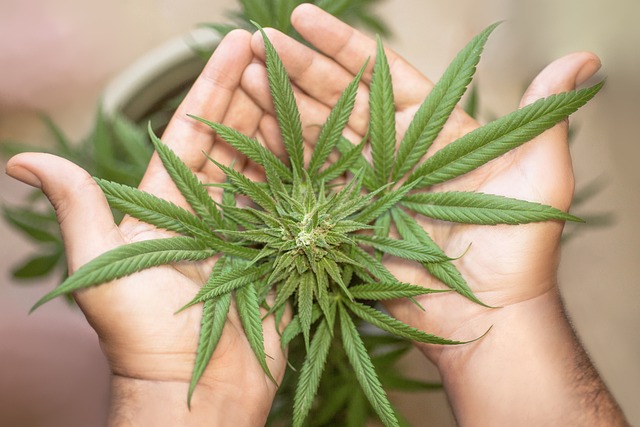The THCA flower, rich in therapeutic cannabinoids like THCA and complemented by a complex array of terpenes such as myrcene, limonene, caryophyllene, and linalool, presents a unique blend that can influence health through the entourage effect, where the compounds work synergistically to enhance their individual benefits. This effect is crucial in optimizing the flower's potential in therapeutic settings. Research on THCA flower is ongoing, focusing on its interactions with the endocannabinoid system and the balance of therapeutic effects against possible side effects like dry mouth or eyes, mild anxiety, paranoia, or dizziness, which may occur in some individuals, especially in larger doses. The variability in individual responses necessitates a personalized approach to using THCA flower, with considerations for one's health status and concurrent medication use. By understanding the specific profiles of different strains, users can better align their consumption with health goals while minimizing adverse effects. This knowledge is essential for responsible use and for fully realizing the benefits offered by THCA flower, terpenes, and cannabinoids.
Exploring the complex interplay between terpenes and cannabinoids in THCA flower, this article sheds light on its potential side effects. As we delve into the medicinal and psychoactive properties of this non-intoxicating cannabinoid, understanding its impact on health and well-being becomes paramount. Join us as we navigate through the scientific landscape, highlighting key findings to inform and guide readers on the effects of THCA flower.
- Unraveling the Effects of THCA Flower: A Deep Dive into Terpenes and Cannabinoids
- Navigating the Potential Side Effects of THCA Flower: Understanding the Interplay of Terpenes and Cannabinoids
Unraveling the Effects of THCA Flower: A Deep Dive into Terpenes and Cannabinoids

Unraveling the effects of THCA (Tetrahydrocannabinolic Acid) flower involves a complex interplay between its cannabinoid profile and the rich array of terpenes it contains. THCA, the raw form of THC (Tetrahydrocannabinol), is known to possess potential therapeutic properties without the psychoactive effects associated with its decarboxylated counterpart. The entourage effect, a phenomenon where the combined action of cannabinoids and terpenes enhances their individual effects, is particularly significant in THCA flower. Terpenes, the aromatic compounds found in cannabis, play a crucial role in this synergy. Each terpene contributes unique scents and flavors, as well as distinct modulatory activities on the endocannabinoid system, influencing both the therapeutic and psychoactive properties of the flower.
Investigating THCA flower’s effects requires a nuanced approach that considers not only the cannabinoids like THCA but also the synergistic interactions with other compounds like terpenes such as myrcene, limonene, caryophyllene, and linalool. Myrcene, for instance, is known for its sedative properties, while limonene may provide an uplifting effect. Caryophyllene offers anti-inflammatory benefits, and linalool can have both calming and invigorating effects. The presence of these terpenes can influence the overall experience and therapeutic potential of THCA flower, making it a subject of growing interest for researchers and consumers alike. Understanding the precise mechanisms by which these compounds interact is essential for harnessing their full medicinal potential while minimizing any adverse side effects. As such, the study of THCA flower and its components is an ongoing field of research with promising implications for various therapeutic applications.
Navigating the Potential Side Effects of THCA Flower: Understanding the Interplay of Terpenes and Cannabinoids

Navigating the potential side effects associated with THCA flower requires a nuanced understanding of its complex chemical composition, particularly the interplay between terpenes and cannabinoids. Tetrahydrocannabinolic acid (THCA) is the raw, non-psychoactive precursor to the well-known psychoactive compound THC, found in hemp and cannabis plants. It’s the presence of these cannabinoids along with a diverse array of terpenes that contribute to the multifaceted effects of THCA flower. These compounds work synergistically to produce various therapeutic benefits, but they can also lead to certain side effects in some individuals.
Terpenes are aromatic compounds responsible for the distinctive scents and flavors of cannabis strains, and they play a significant role in modulating the effects of cannabinoids like THCA. Each terpene profile offers unique therapeutic properties and can influence the potency and character of the strain. For instance, myrcene is known for its sedative and pain-relieving qualities, while limonene is associated with mood elevation and energy. Understanding these dynamics is crucial when considering the side effects, which may include dry mouth or eyes, mild anxiety, paranoia, or dizziness in some individuals, especially at higher doses. It’s important for consumers to be aware of their sensitivity to THCA and its components, as well as to consult with healthcare professionals before use, particularly if they have pre-existing health conditions or are taking other medications. By educating oneself on the specific terpene and cannabinoid profiles of different THCA flower strains, users can make informed decisions that align with their personal wellness goals while minimizing any adverse effects.
In our exploration, it’s evident that THCA flower interacts with the body through its unique blend of terpenes and cannabinoids, which can yield a spectrum of effects. While this natural compound holds promise for various therapeutic applications, it’s crucial to approach its use with an informed perspective on its potential side effects. As outlined, understanding the nuanced relationship between these active components is key to safely integrating THCA flower into one’s wellness regimen. Users should consult with healthcare professionals to navigate its effects responsibly and consider individual health factors when incorporating this cannabinoid-rich botanical. With diligent research and professional guidance, the therapeutic potential of THCA flower terpenes and cannabinoids can be harnessed effectively and safely.
